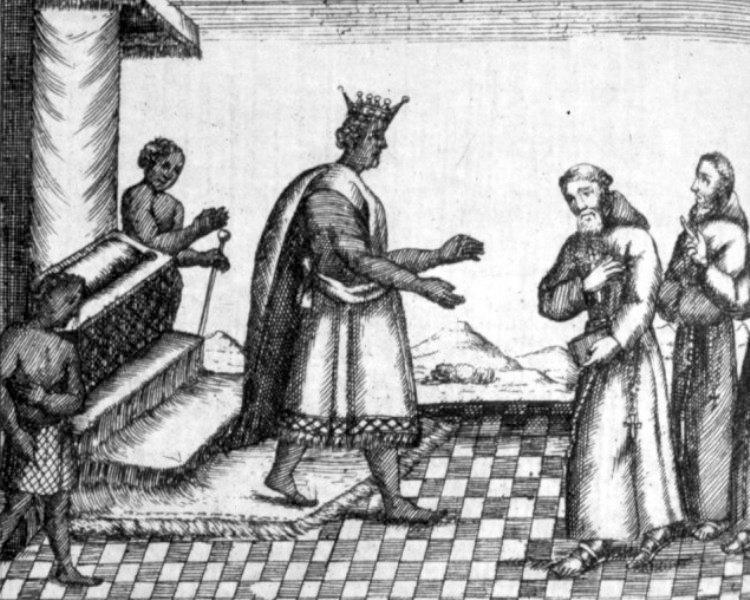
African Empires: The Kongo Kingdom (14th-19th Centuries)

Figure 1.-- This engraving come from a book published in Milan (1690) by Giovanni Antonio Cavazzi: 'Istorica Descrizione de Tre Regni Congo, Matamba, et Angola'. It shows Kongo King Garcia II (1641-60). He is receiving a group of Capuchin missionaries. We don't know how accurate the depiction is. The crown is presumably an European symbol to indicate that he is the king rather than something Garcia may have worn. However his bare feet and the shirtless boys suggest that the image may be accurate. At the time in equatorial Africa the children didn't wear any clothing, but the king's attendants my hace worn some clothes on special occasions.
|
|
The Kingdom of Kongo was a powerful African state which deveoped along the Atlantic coast of Central Africa centering on the western area of the Congo River Basin. The present Democratic Republic of Congo the Republique de Congo (Brazzaville-Congo) are named after the Kongo Kingdom, but do not have boundaries similar to the Kingdom. The Kongo Kingdom was founded just before the arrival of the Europeans and would play a major role in the development of the Atlantic slave trade.
Because of the extensive contacts with the Europeans, we know much more about the Kongo Kingdom than many of the earlier African empires. The Kongo Kingdom developed as the most powerful of several Africn states along Africa's western (Atlantic) coast. Historians refer to them as the Middle Atlantic kingdoms. The Kongo Kingdom began to grow when a militarized group of Bakongo (Kongo people) crooed the Kongo and moved south (late-14th centurty). They moved into northern Angola, conquering the differet people they encountered. They founded Mbanza Kongo (Mbanza Congo) which became the capital. The Bakongo achieved success in part because they tended to assimilate the conquered tribes rather thn subjct them. The people of the area conquered thus gradually became one people with aense of identity and were ruled by leaders which had both religious and political authority and legitimacy (mid-15th century).
Portuguese navigator Diogo Cão established contact with the Kongo Kingdom and traveled to Mbanza Kongo. He established diplomatic and commercial relations between Portugal and Kongo (1485). Portugal did not attempt to conquer the African kingdoms and colonize the interior in the same way that the Spanish Conquistadores would do in the Americas. The territory of the Kongo Kingdom varied over time, but was primarily the Atlantic coast and adjacent interiorfrom the present Democratic Republic of Congo south to northern Angola. While a monarchial state, each successive ruler was not necessarily the eldest son, although this was often the case. Each successibe king was elected by a Royal Council, from amongst the descendants of the canonical (Kimpanzu or Kimulazu) clans. The capital city was is Mbanza Kongo. There were six provinces: Mpemba, Mbata, Nsundi, Mpangu, Mbemba and Soyo as well as four vassal Kingdoms: Loango, Cacongo and Ngoye, at the North of the N'Zari river, and Ndongo, at the South of the Congo river.
HBC

Navigate the Historic Boys' Clothing Web Site:
[Return to the Main African kingdom and empire page ]
[Return to the Main Angolan history page ]
[Return to the Main Congo history page ]
[Return to the Main Slave trade: African political structure page]
[Introduction]
[Activities]
[Art chronologies]
[Biographies]
[Chronology]
[Countries]
[Photography]
[Style Index]
[Bibliographies]
[Contributions]
[FAQs]
[Glossaries]
[Images]
[Links]
[Registration]
[Tools]
[Boys' Clothing Home]
Created: 4:36 PM 2/25/2013
Last updated: 7:53 PM 3/2/2013



